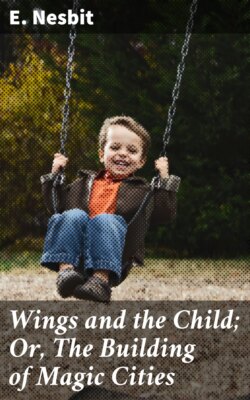Читать книгу Wings and the Child; Or, The Building of Magic Cities - E Nesbit - Страница 6
CHAPTER III
ОглавлениеPlaythings
The prime instinct of a child at play—I do not mean a child at games—is to create. I use the word confidently. He will make as well as create, if you let him, but always he will create: he will use the whole force of dream and fancy to create something out of nothing—over and beyond what he will make out of such materials as he has to hand. The five-year-old will lay a dozen wooden bricks and four cotton reels together, set a broken cup on the top of them, and tell you it is a steam-engine. And it is. He has created the engine which he sees, and you don't see, and the pile of bricks and cotton reels is the symbol of his creation. He will silently borrow your best scissors and cut a serrated band of newspaper, which he will fasten round his head (with your best brooch, if he cannot find a pin), hang another newspaper from his shoulders, and sit in state holding the hearth-brush. He will tell you that he is a king—and he is. He has created crown, robes, sceptre, and kingship. The paper and the rest of it are but symbols.
HE HAS CREATED THE ENGINE.
And you shall observe that the toys which the child loves best are always those toys which lend themselves to such symbolic use.
THE TOMB IN THE DESERT.
18]
Christmas is at hand. You go to buy gifts for the child, in memory of that Other Child whose birthday gifts were gold, frankincense, and myrrh. You go into the toyshops, elbowing your way as best you can, looking for such toys as may aid the child in his work of creative imagination.
You find a vast mass and litter and jumble of incredible futilities—things made to sell, things made by people who have forgotten what it is like to be a child. Mechanical toys of all sorts, stupid toys, toys that will only do one thing, and that thing vulgar and foolish. And, worst outrage of all, ugly toys, monstrosities, deformities, lead devils, grinning humpbacked clowns, "comic" dogs and cats, hideous mis-shapen pigs, incredible negroes, intolerable golliwogs. All such things the natural child, with a child's decent detestation of deformity, will thrust from it with screams of fear and hatred, till the materialistic mother or nurse explains that the horror is not really, as the child knows it to be, horrible and unnatural, but "funny." Thus do we outrage the child's inborn sense of beauty, which is also the sense of health and fitness, and teach it that deformity is not shocking, not pitiable even, but just "funny." All these ugly toys are impossible as aids to clean imagination.
So, almost in as great, though not in so harmful a degree, is the "character doll." The old doll was a doll, and not a character. Therefore she could assume any character at your choice. The character doll is Baby Willy, and can never be anything else, unless imagination, exasperated and baffled, christens him Silly Billy in the moment of furious projection across the nursery floor. But the old doll, with her good, expressionless face and clear blue eyes, could be a duchess or a dairymaid, a captive princess or a greengrocer's wife keeping shop, a cruel stepmother or Joan of Arc. I beg you to try Baby Willy in the character of Joan of Arc.
You cannot hope to understand children by common-sense, by reason, by logic, nor by any science whatsoever. You cannot understand them by imagination—not even by love itself. There is only one way: to remember what you thought and felt and liked and hated when you yourself were a child. Not what you know now—or think you know—you ought to have thought and liked, but what you did then, in stark fact, like and think. There is no other way.
Do you remember the toys you liked, the toys you played with? Do you remember the toys you hated—after the fading of the first day's flush of novelty, of possession? The houses with doors that wouldn't open? The stables with horses that wouldn't stand up? The shops whose goods were part of their painted shelves, whose shopmen were as fast glued behind the counter as any live shop-assistant before the passing of the Shops Act?
And the mechanical toys—the clockwork toys. The engine was all right, even after the clockwork ran down for the last time with that inexorable whizz which told you all was over; you could build tunnels with the big brown books in the library and push the engine through with your hand—it would run quite a long way out on the other side. But the other clockwork things! How can one love and pet a mouse, no matter how furry its superficial exterior, when underneath, where its soft waistcoat and its little feet should be, there is only a hard surface from which incompetent wheels protrude? And the ostrich who draws a hansom cab, and the man who beats the boy with a stick? When they have whizzed their last, who cares for the tin relics outliving their detestable activities?
Think of the toys you liked: the Noah's Ark—full of characters. What stirring dramas of the chase, what sporting incidents, what domestic and agricultural operations could be carried out with that most royal of toys. Mr. Noah, I remember, was equally competent and convincing as ploughman or carter. But his chief rôle was Sitting Bull. His sons were inimitable as Chingachgook and scalp hunters generally. You cannot play scalp hunters with the mechanical ostrich indissolubly welded to a hansom cab.
